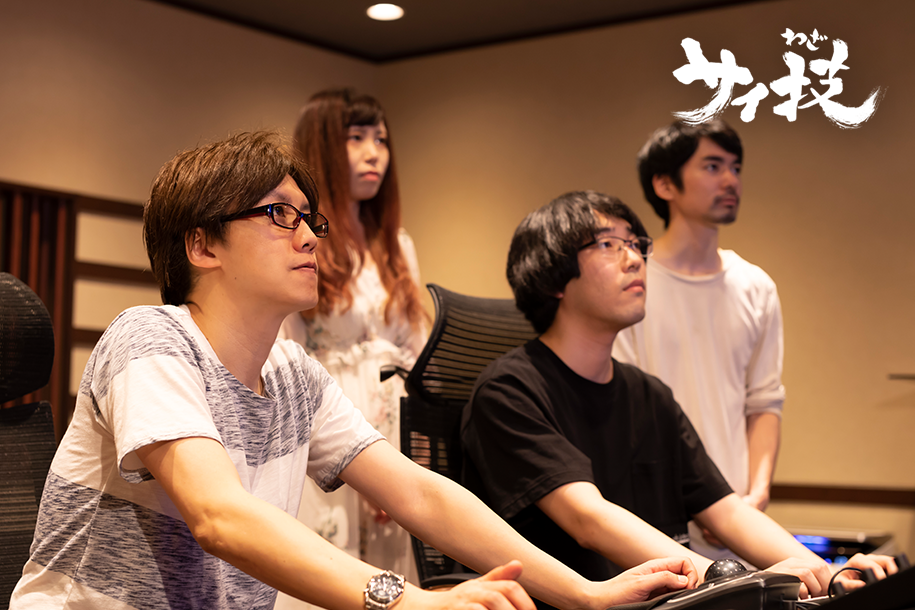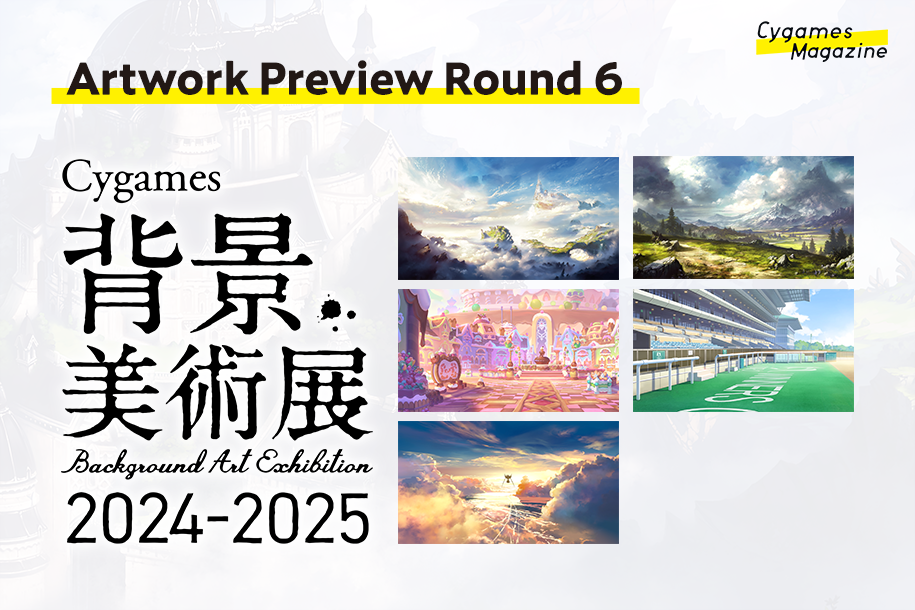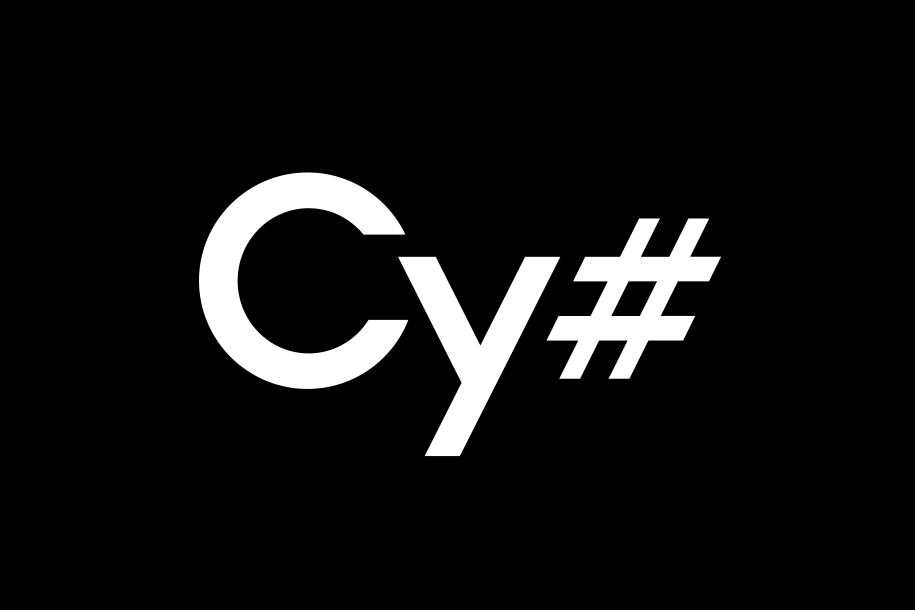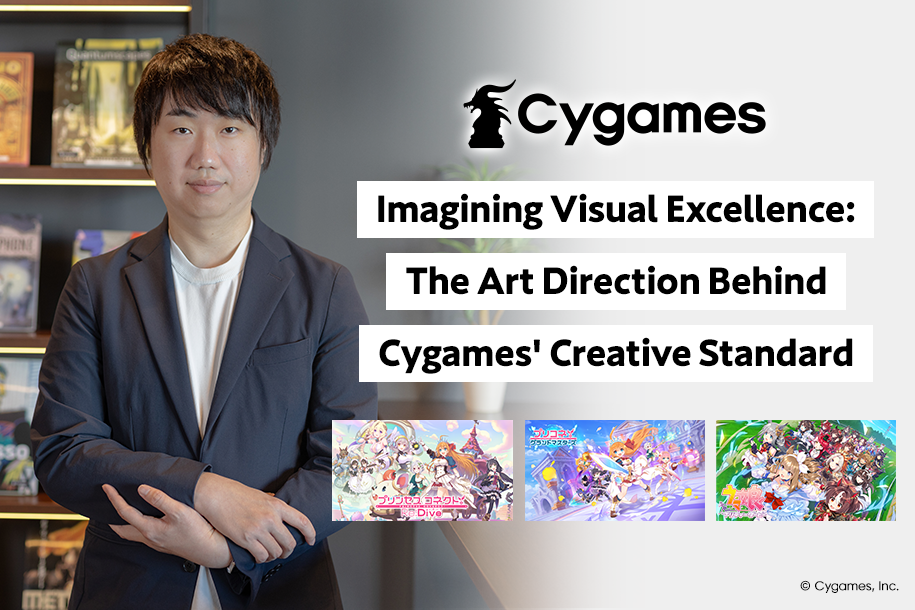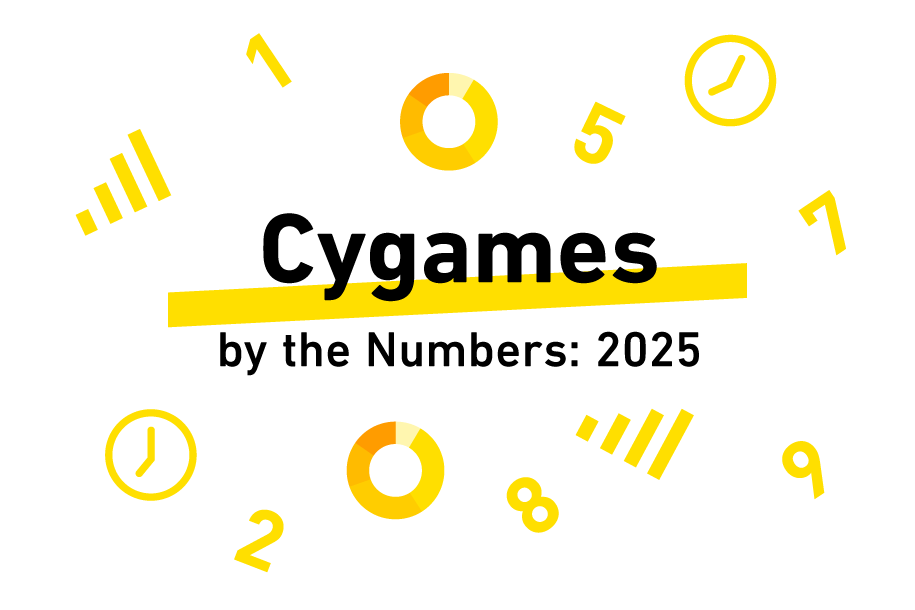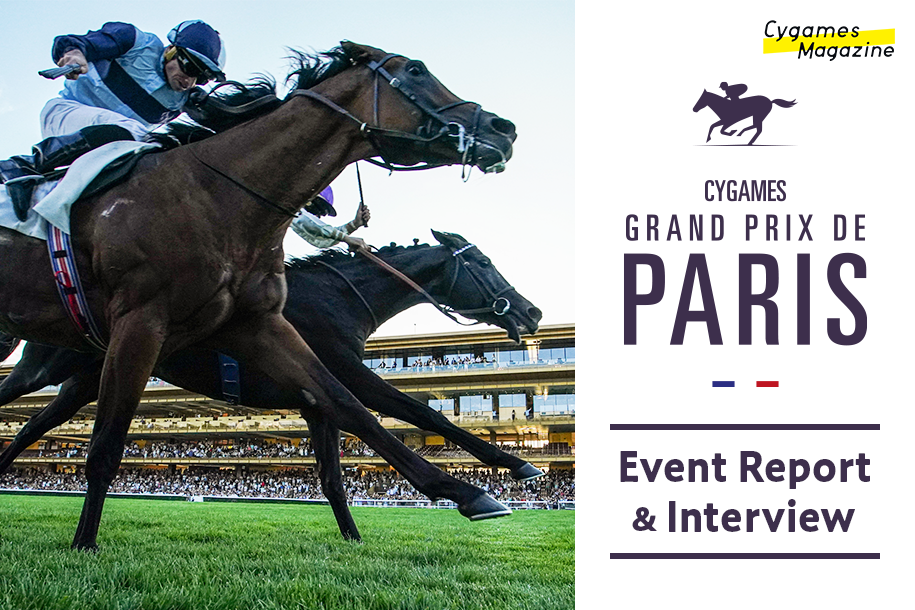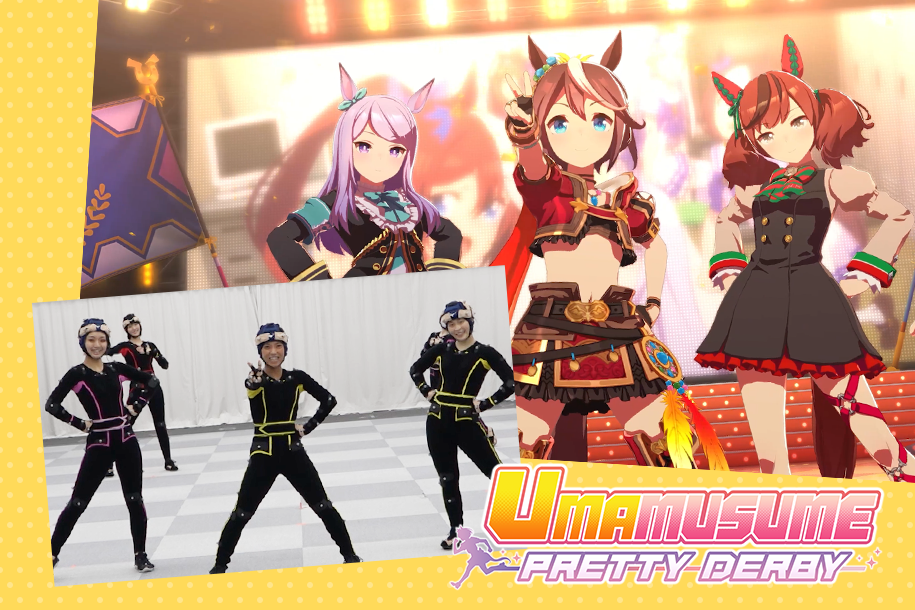Season 2 Confirmed! A Look Behind the Scenes of Princess Connect! Re: Dive
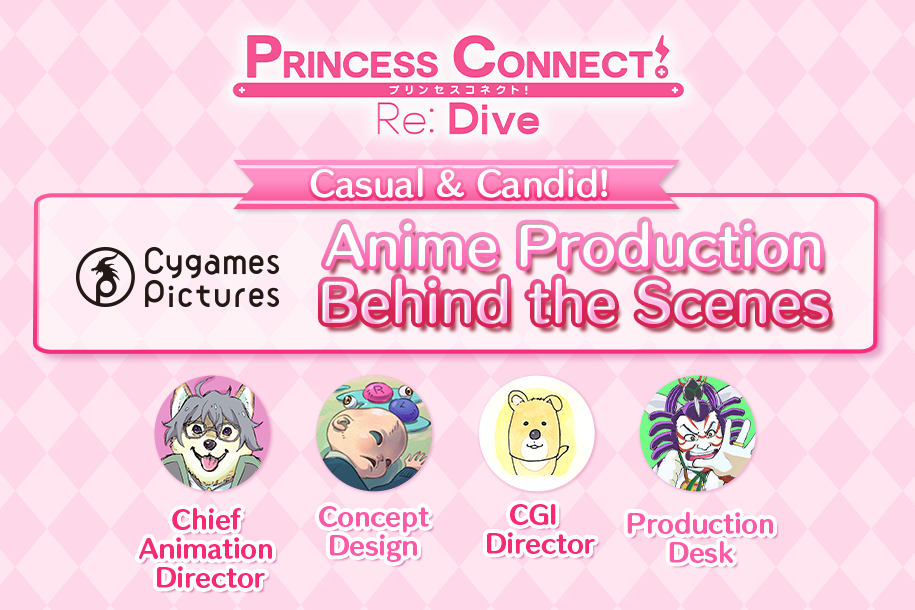
Princess Connect! Re: Dive (hereinafter referred to as “Re: Dive”) has finished its first season, and a second season has already been decided. The production staff of CygamesPictures, Inc. (hereinafter referred to as “CyPic”) held a round-table discussion. We asked them ten questions to get to the bottom of what they’re really thinking!
- CygamesPictures, Inc. Chief Animation DirectorMyungjin
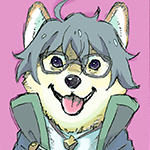
- In charge of drawing. In addition to drawing with paper and pencil, he also assists with line correction and coloring. He has been in the industry for eight years and joined CyPic in January 2019.
- CygamesPictures, Inc. Concept DesignMasaki
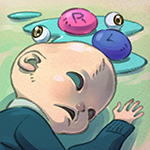
- In charge of prop design and artistic direction for the setting. He has been involved with CyPic since its early days.
- CygamesPictures, Inc. CGI Producer, CGI DirectorYoshinori

- In charge of 3DCG production and rendering items and buildings that appear in the anime. He has been in the industry for about eight years and joined CyPic about a year and a half ago.
- CygamesPictures, Inc. Production DeskTakuma
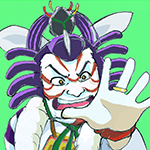
- As the man behind the production desk, he is mainly in charge of overall schedule management. He has been in the animation industry for about ten years and joined CyPic about a year ago.
▼Question 1: How do you feel now that the first season has finished airing?
▼Question 2: What were you conscious of when adapting a game into an anime?
▼Question 3: What was the most difficult part of the production process?
▼Question 4: What are the key points to enjoying the anime more?
▼Question 5: What do you like most about the Re: Dive anime?
▼Question 6: What was the most memorable moment for you?
▼Question 7: What is your impression of CyPic as a member of the staff?
▼Question 8: Going forward, what do you think will be your main challenges for production and maintaining quality?
▼Question 9: What kind of people are best suited to work in animation production at CyPic?
▼Question 10: Do you have any personal goals for the second season?
Question 1:
How do you feel now that the first season has finished airing?
- Masaki (Concept Design)

- It still doesn’t feel over. (laughs) I haven’t even finished the package design for Season 1 and I’m already working on Season 2.
- Myungjin (Chief Animation Director)

- I was working non-stop and, before I knew it, Season 1 was finished. I still haven’t completely processed it in my head. (laughs)
- Takuma (Production Desk)

- That’s true, it doesn’t feel like it’s over.
I do feel a sense of accomplishment over the fact that we were able to get through the state of emergency and finish the production on time though.
- Masaki (Concept Design)

- Yeah, it happened right when we were in a busy part of the production process.
- Takuma (Production Desk)

- We ended up on a fairly tight schedule, and actually discussed whether or not to postpone the TV broadcast. Progress during July and August was the toughest.
- Yoshinori (CGI Director)

- No one has ever experienced a situation quite like this.
- Takuma (Production Desk)

- In addition to my regular work, I had to decide how to handle remote work and balance production with all kinds of evaluations.
- Yoshinori (CGI Director)

- The entire company shifted to remote work in April, right?
- Masaki (Concept Design)

- Preparations for working remotely had already begun in March, so the transition was relatively smooth.
In the anime industry as a whole, many productions were delayed due to disruptions in recording schedules. Fortunately all the lines for Re: Dive had already been recorded, so there was no change in the original schedule.
- Yoshinori (CGI Director)

- The Covid-19 pandemic taught us some valuable lessons.
I not only have a better grasp of my own work, but also on the inner workings of other departments as well.
- Myungjin (Chief Animation Director)

- Those who were able to draw from home worked remotely. Those who had face-to-face obligations came to the office.
- Takuma (Production Desk)

- I think being able to work in a remote environment is one of our strengths.
Question 2
What were you conscious of when adapting a game into an anime?
- Myungjin (Chief Animation Director)

- I wanted to play to animation’s unique strengths. I feel that characters in anime have a much wider range of facial expression and body language.
- Takuma (Production Desk)

- The anime’s script is also a lot longer than the in-game cut-scenes, so there’s more opportunity for character development.
- Myungjin (Chief Animation Director)

- That’s right. You get to know the characters better as the season progresses, which I think makes it more and more interesting as you go.
- Masaki (Concept Design)

- As for the setting, we had to simplify the design to make it easier for the artists to draw and animate the characters, but it’s very difficult to find a way to pare down the design without compromising the look and feel of the original game.
- Yoshinori (CGI Director)

- Does the balance come down to your aesthetic judgement?
- Masaki (Concept Design)

- There’s no set method for it, so I think it varies a lot depending on who does it.
I tend to keep the original silhouette, but reduce the amount of details on clothes and items.
- Myungjin (Chief Animation Director)

- You made some bold changes too though, didn’t you?
- Masaki (Concept Design)

- That’s right. For example, in the original game design, the tip of Karyl’s staff is decorated with the whole body of a cat, but in the anime, I took the liberty of changing it to just the head. I hope the fans of the original game won’t find it strange.

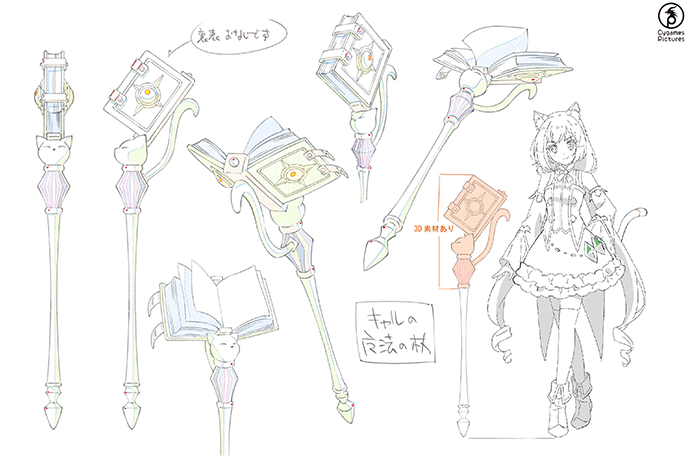
Question 3
What was the most difficult part of the production process?
- Takuma (Production Desk)

- It’s always a balancing act between quality and deadlines. I think it’s a matter of securing the time and workers to finish the project on time to a quality standard where we’re comfortable releasing it to the world. There may have been a few instances of things not making the cut. (laughs)
The director gave us all sorts of tasks for improving the final product, but since production resources are limited, it’s sometimes difficult to implement all of them…
It’s production’s job to organize the project in a way that the director and episode directors’ goals are fully accomplished, but if we’re on a tight schedule, we sometimes have to adapt to the time we’ve got.
- Yoshinori (CGI Director)

- That’s the hardest part of being a production coordinator, isn’t it? I can understand why the director may want to do something to raise the quality, but as the deadline draws closer, you know how it goes…
- Takuma (Production Desk)

- Right. There are times when I have to tell the director, “I can’t do that,” simply because some requests are not feasible either for lack of resources of for lack of time.
- Myungjin (Chief Animation Director)

- In terms of drawing, I have the impression that it was difficult to draw Pecorine and Yuuki. Capturing the atmosphere and nuance of these two characters was tricky.
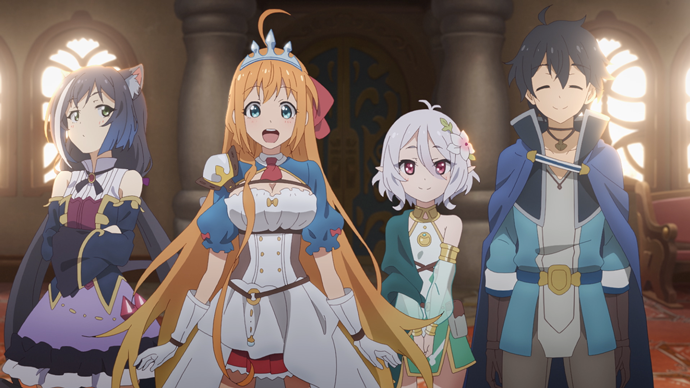
- Masaki (Concept Design)

- What was particularly difficult about it?
- Myungjin (Chief Animation Director)

- There were several artists involved in the drawing process, and there was quite a bit of variation in the drawings they produced.
Kokkoro and Karyl are Kokkoro and Karyl no matter who draws them, but Pecorine and Yuuki are drawn in different ways by different people, and it was a challenge to ensure consistency.
- Masaki (Concept Design)

- Myungjin, you were in charge of fixing the pictures that were submitted by the artists, weren’t you? You probably needed to fix these inconsistencies as well.
- Myungjin (Chief Animation Director)

- That’s right. There were a lot of facial expressions that were not in Karyl’s model sheet, but strangely enough, no matter what kind of expression she was making, it was still Karyl through and through.
Yuuki, on the other hand, sometimes turned out like a completely different person even though the style guide was followed as closely as possible.
- Masaki (Concept Design)

- That’s interesting. It seems characters with a wider range of facial expressions have more room for variation.
- Yoshinori (CGI Director)

- The CG department was created in conjunction with the start of production for the Re: Dive anime, so it was difficult to set up the systems and work on CG production at the same time.
- Takuma (Production Desk)

- Yoshinori, you were the only member of the CG department at first, weren’t you?
- Yoshinori (CGI Director)

- That’s right. I was in charge of setting up the systems in addition to animating an entire TV series. (laughs)
It was rough at first, but we recruited more staff and now have seven people on our team. We hope to bring even more people on board in the future.
- Takuma (Production Desk)

- One of the new graduates who joined the company last year also played an active role.
- Yoshinori (CGI Director)

- That’s right. After the training period, we asked them to work on the last three episodes of the series. We were very lucky that they were able to produce work that was broadcast-quality all on their own.
They said they were really happy when they saw the broadcast too.
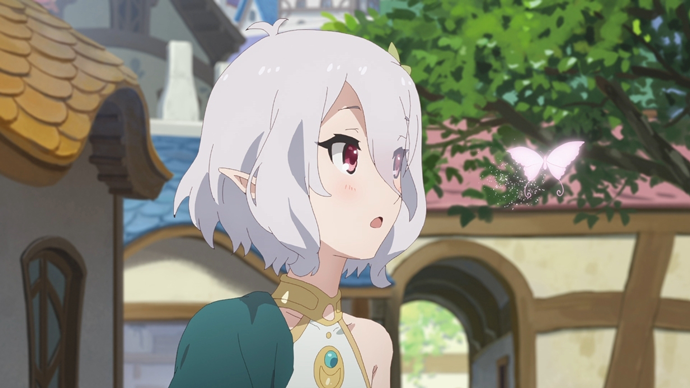
- Masaki (Concept Design)

- When it came to the prop and art settings, I had to be very careful not to ruin the atmosphere of the original game, but since I’m kind of a jack-of-all-trades, I had a lot of work coming in whenever I had free time. (laughs)
- Yoshinori (CGI Director)

- Concept designers are always busy at the beginning, but tend to have more time on their hands later when other departments are busy. The concept planning and design needs to be done before we can move on to other work like drawing or shooting, after all.
- Masaki (Concept Design)

- Right, once the initial concept design and planning was finished, I helped out with other things. I ended up working on the layout, as well as the art for the ending sequence.
- Takuma (Production Desk)

- Masaki, you also did the coloring for the ending sequence, didn’t you?
The director wanted the ending to be drawn the way concept art is, so I was worried how it would turn out, but it was really beautiful.
- Masaki (Concept Design)

- Thank you. I don’t usually do coloring so it was a bit of a challenge.
Question 4
What are the key points to enjoy the anime more?
- Myungjin (Chief Animation Director)

- Since it’s an anime, I hope that people will enjoy the animation and dialogue as much as possible. I think we gave the characters new depth.
- Yoshinori (CGI Director)

- For the CG, I hope people will notice how we used a few different visual styles.
Even with CG, some elements are made with a 2D cel-shaded look, and some elements are made with an obvious CG look. We used the different styles in different ways.
- Takuma (Production Desk)

- What was your intention in creating an obvious CG-like texture?
- Yoshinori (CGI Director)

- I think it would be most interesting for the viewer to try to think about the intentions behind it while watching it.
I’m very particular about CG in the Re: Dive anime, and the director told me that he wanted to use different kinds of 3D expressions depending on what kind of direction he wanted to take a scene.
- Masaki (Concept Design)

- Hmm, that sounds a bit abstract. (laughs)
- Yoshinori (CGI Director)

- To give a simple example, the shadow creatures that appear in episodes 7 and 12 have a very CG-like texture. We used that to highlight the fact that they are not from this world.
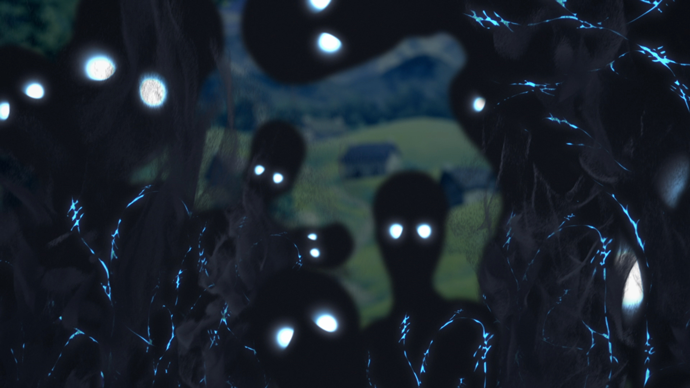
- Takuma (Production Desk)

- I see.
- Yoshinori (CGI Director)

- CG-related style choices like that were made by the director and passed on to us, so the director and CG department are the only ones who know the reasoning behind them. I hope that people will notice the CG elements and consider what creative decisions into them.
- Masaki (Concept Design)

- I never get tired of the opening no matter how many times I watch it. The music is good and the animation is so smooth. I’m impressed with the quality of the opening video, the people in charge of it have done a great job.
- Myungjin (Chief Animation Director)

- It was made in a surprisingly short amount of time.
- Takuma (Production Desk)

- The schedule was really tight around that time. Thankfully, with everyone working together, we went from “this is bad” to “this is badass!” (laughs)
- Myungjin (Chief Animation Director)

- The quality of the background art is amazing. I think it’s an element that raises the overall level of the work. I think the general audience tends to overlook this, so I’d be happy if people paid attention to it when they re-watch the series.
- Masaki (Concept Design)

- Also, in the ending, there is a cut where Pecorine is fixing her hair. There’s a lace doily hanging from a shelf in the background which is actually drawn to look like a wing.
- Yoshinori (CGI Director)

- Was that your idea, Masaki?
- Masaki (Concept Design)

- It wasn’t my intention from the start but as I was drawing the lace, I thought “it kinda looks like a wing.” So I secretly ran with it.
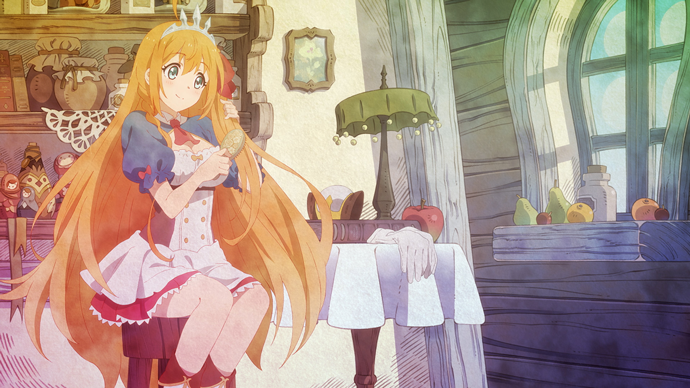
Question 5
What do you like most about the Re: Dive anime?
- Takuma (Production Desk)

- For me personally, there’s a scene in Episode 3, where Kokkoro wants Karyl to join the guild, and she fidgets with the guild application form. I like Kokkoro’s fidgety movements the most. I think her personality and characterization really shine in moments like that. She’s simply adorable. (laughs)
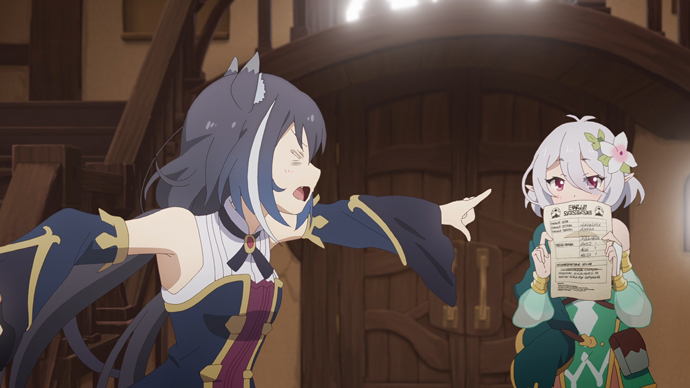
- Myungjin (Chief Animation Director)

- For me, it was the battle scene with the mushrooms in the first episode. It was the first scene where a full-scale battle was depicted in the work, and when I saw it, I knew that this would be an interesting project.

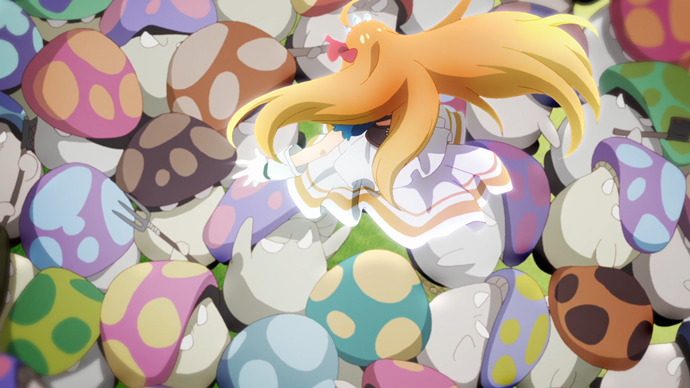
- Yoshinori (CGI Director)

- It has nothing to do with CGI at all, but I like the scene in Episode 12 where Karyl, Ikacchi and Charlie are walking side by side. I think it’s interesting that the main characters and the secondary characters are interacting, so you can get a sense of their everyday lives.
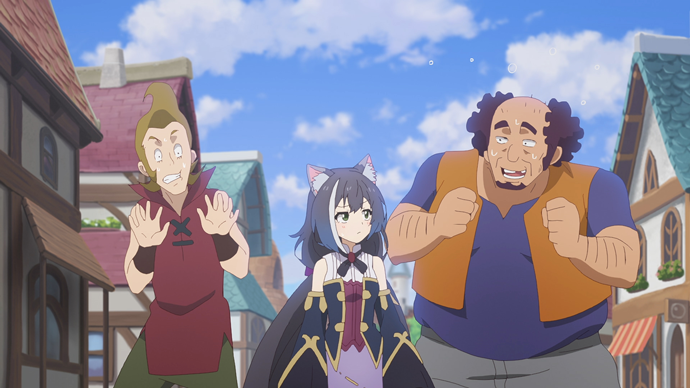
- Myungjin (Chief Animation Director)

- It’s also pretty unique that there are always scenes with characters eating.
- Takuma (Production Desk)

- In fact, the Re: Dive anime had its own culinary art director.
They thought up dishes that would fit in with the RPG setting, such as the ones using insects, and made sure they looked appealing. There were even times when we had to do retakes because of the appearance of the dishes.
- Yoshinori (CGI Director)

- Was it Episode 3 where they served tea at the Cockatrice’s Nest restaurant? There were a lot of retakes, weren’t there?
- Masaki (Concept Design)

- Retakes? For tea?
- Takuma (Production Desk)

- They told us the shape of the teacup was crooked and it made the highlights look odd.
The tea isn’t even particularly prominent in the scene. It probably doesn’t even occupy 10% of the frame. (laughs)
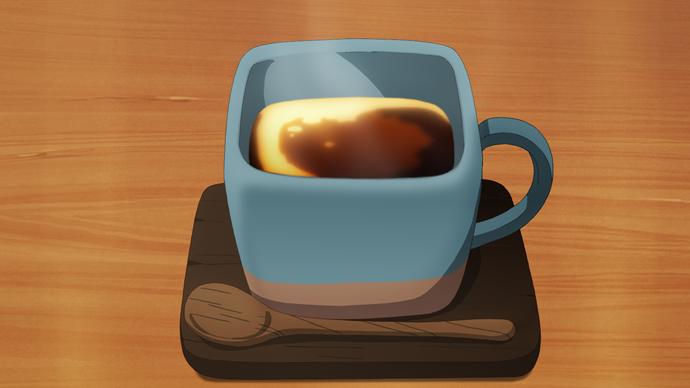
- Yoshinori (CGI Director)

- It’s not even supposed to be a cooking anime… (laughs)
Since the main characters’ guild is called the “Gourmet Guild,” I think the director wanted to put special emphasis on the food.
- Masaki (Concept Design)

- The Gourmet Guild isn’t just about eating delicious food. They also gather and grow ingredients, and cook the food themselves. I think the depictions of how it’s part of their lifestyle makes the food look even tastier.
- Yoshinori (CGI Director)

- The food needs to look delicious at every stage.
- Masaki (Concept Design)

- The purpose of the Gourmet Guild is to “search for the most delicious food in the world,” but there are many areas where their functions as a guild are shown. Pecorine made their dining table by hand.
I like the anime’s show-don’t-tell approach to depicting the characters’ self-sufficient lifestyle.
- Myungjin (Chief Animation Director)

- That’s deep.
- Masaki (Concept Design)

- On top of that, eating doesn’t just satisfy the characters’ hunger. There are also scenes where it satisfies characters’ internal emotional conflicts.
I think that’s what makes it feel so convincing when Pecorine says, “Food really is the source of all life! ☆” I hope viewers can feel that part of the story.
Question 6
What was the most memorable moment for you?
- Takuma (Production Desk)

- When production wrapped.
Once all the parts are finished, there is a retake process to make corrections, etc. Getting through the retake process and delivering the finished product is the best part for me. There were times when we had to work until the very last minute.
- Masaki (Concept Design)

- It was a battle right up to the finish line.
- Myungjin (Chief Animation Director)

- I’m happy we were able to get through it as a team.
While they’re not here at the moment, I also want to mention how impressed I am with the post-processing staff. Even scenes that had me worried in the drawing phase came back looking amazing.
- Takuma (Production Desk)

- Post-processing is usually done in the final stages so there’s often less time to work on it.
Even in those circumstances, they were able to put in renderings that suited the scene. The effects in the battle scenes were done with a lot of flair to raise the quality. Everyone involved in the project was trying hard to deliver the highest-quality product possible.
- Yoshinori (CGI Director)

- That’s less to do with the story and more with the production, though.
The slogan of our CG department was “Come to work on time, go home on time, and do your best work in between.” I thought it was great that we were able to live up to our slogan from the beginning right up to the end.
- Takuma (Production Desk)

- That’s great. When we have free time, we sometimes help other departments. While the workload is divided into specialized steps, lending a hand where you can is part of the work culture at CyPic.
- Masaki (Concept Design)

- For me, I don’t dwell so much on “what went well,” but rather on “what could have gone better?” I’m always thinking of things to improve.
- Takuma (Production Desk)

- Masaki, your work was very well-received by the director and Kusanagi’s team [who did the background art]!
- Masaki (Concept Design)

- I really appreciate that. I try to do as much as I can within the schedule. It’s just that later on, I find myself thinking, “I wish I could have done more here.”
- Yoshinori (CGI Director)

- Masaki also designed the clock that appears in the anime and made a rough sketch of it. Working on the CG for it was a really interesting and rewarding experience.
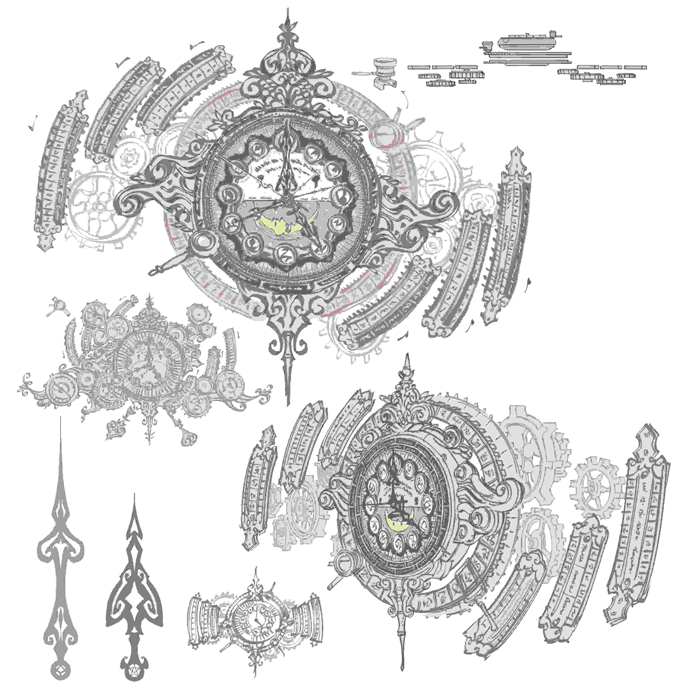

- Masaki (Concept Design)

- I’m happy you think so. I think hearing that might be the most memorable moment for me now. (laughs)
Question 7
What is your impression of CyPic as a member of the staff?
- Takuma (Production Desk)

- At a seminar for new graduates, our director Takenaka [Nobuhiro], said “at our company, no one ever gives up on creating interesting animation.”
- Masaki (Concept Design)

- Everyone is always striving to create something great, aren’t they?
- Takuma (Production Desk)

- In the animation production field, work hours tend to be different for each type of work, but at CyPic, we work under the basic policy of coming in at 10 in the morning and leaving at 7 at night.
Realistically speaking, there are plenty of times we’re not able to make that happen, but it’s important that everyone keeps the ideal schedule in mind! (laughs)
- Myungjin (Chief Animation Director)

- Even though the company runs like a well-oiled machine, I like that it’s still easy to ask others for advice depending on the circumstances.
- Yoshinori (CGI Director)

- Does that include being flexible with external staff?
- Myungjin (Chief Animation Director)

- That’s right. In some cases, freelance artists come to work at CyPic, and they can use the company’s facilities whenever they want.
- Masaki (Concept Design)

- It’s definitely a good working environment.
- Yoshinori (CGI Director)

- I think the office is well-outfitted. They’re very thoughtful when it comes to our equipment, chairs, and other office fixtures.

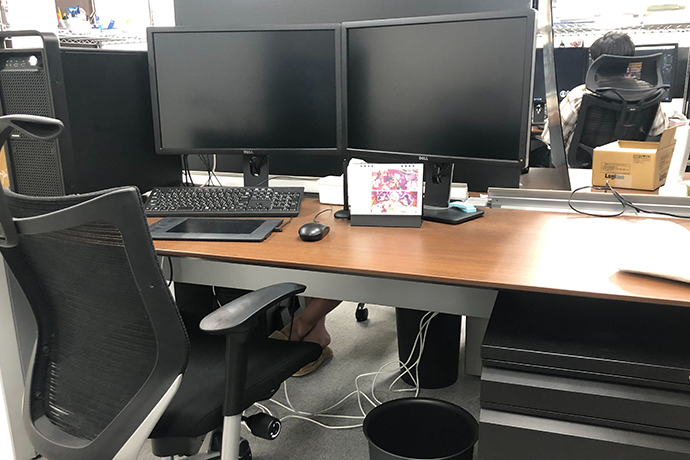
- Takuma (Production Desk)

- Also, I think it’s an environment where you can feel yourself grow.
During the production of the Re: Dive anime, we were able to bring a lot of skilled people into the production department while focusing on quality right to the end. This accomplishment in particular, shows how the production department, myself included, has grown.
- Myungjin (Chief Animation Director)

- I feel a sense of growth when I get compliments from those around me.
It gives me motivation to do even better next time.
- Yoshinori (CGI Director)

- I think those of us who work with our hands will tend to agree with Myungjin.
I tend to focus on the things I need to reflect on or improve, so when someone says, “that was really good,” I feel like I’ve grown.
- Masaki (Concept Design)

- I’m getting older and my eyesight is getting worse every day. (laughs)
My shoulders feel stiffer than they used to, this isn’t growth anymore, just aging. It’s hard to maintain the same energy.
- Myungjin (Chief Animation Director)

- People would be hard-pressed to find anything to criticize in your work, though, Masaki.
- Masaki (Concept Design)

- Regardless, I’m working hard every day to make things as good as possible. I want to reflect on things I can improve in a positive way, and move forward step by step.
- Yoshinori (CGI Director)

- I think this is an environment where you can keep thinking about your own growth.
- Masaki (Concept Design)

- The fact that I am able to not only keep up with my daily work, but also keep improving is probably a sign that I have grown in the first place.
Question 8
Going forward, what do you think will be your main challenges for production and maintaining quality?
- Takuma (Production Desk)

- Since CyPic is still a young company, many of the staff are also young. A lot of us, myself included, still lack experience. I’d like to do something about that.
Almost everything we do in production happens entirely behind the scenes. However, the quality of the work depends on whether we, the younger generation, can attract good artists and whether the workers have time to do good work.
- Yoshinori (CGI Director)

- We had a lot of new graduates join us this year. As a company, we also have a goal of increasing the number of production lines.
- Myungjin (Chief Animation Director)

- The same goes for drawing. We still don’t have enough people, and we are planning to increase the number. We would like to have a system that can flexibly respond to various projects.
- Masaki (Concept Design)

- I think I’ll also have to say training the next generation… I need to train someone to do concept design.
- Yoshinori (CGI Director)

- We have to train our successors.
- Masaki (Concept Design)

- However, there are certain risks in training people to specialize in concept design.
If we train newcomers specifically for concept work and they don’t learn other skills, it could limit their career possibilities. It would be nice if some of the artists or designers wanted to try branching out into concept design.
Question 9
What kind of people are best suited to work in animation production at CyPic?
- Takuma (Production Desk)

- Within the production process, I think the most important thing is an ability to listen to others.
Listen to people, analyze and understand what they think and what they want, and then work together to solve the problem or make a product.
It’s a rudimentary skill, but a very important one. It can be difficult to master for some.
- Myungjin (Chief Animation Director)

- I would like to see people with good communication skills in drawing as well.
You may not think it has anything to do with drawing, but animation is not created by one person, but by several departments working together as a whole.
You don’t need to be a good speaker, but you do need to be able to listen to others and say what is important. Such people absorb things more quickly.
- Masaki (Concept Design)

- I prefer people who can think and draw on their own.
If I could choose, I’d want someone with multiple aspirations; someone who wants to draw characters, tools, as well as create art settings.
- Yoshinori (CGI Director)

- In the case of CG, and in my case as well, someone who has the desire to put their CG skills to work in the animation industry.
CG has many applications other than anime. So if you want to specialize in using CG in anime and improve your skills, I think you will enjoy working here.
Question 10
Do you have any personal goals for the second season?
- Takuma (Production Desk)

- In the first season, the schedule was a bit loose because we were still getting our footing, but in the second season, we want to tighten things up.
I hope we can continue to improve.
- Myungjin (Chief Animation Director)

- To draw better than in the first season.
I want to make the characters more expressive, and improve consistency in quality.
- Yoshinori (CGI Director)

- I would like to increase the number of elements created with CG, including buildings and characters.
I think it would be interesting to create a cel-shaded look so that the audience would not notice that it was CG.
- Masaki (Concept Design)

- As for concept design, the second season will have new elements, so I want to draw something that will please the viewers.
- Takuma (Production Desk)

- So we’ll do our best to produce the second season as well, and we appreciate the support of all the fans!
It sounds like the staff behind the Princess Connect! Re: Dive anime have some big goals for the upcoming second season. It’ll be exciting to see how they draw and direct the new episodes to make something everyone can enjoy!
We also learned that they’re expanding their workforce and actively recruiting new personnel. The second round of recruitment for new graduates began on November 2, 2020 and is scheduled to end on Friday, January 29, 2021. If you are interested in creating animation at CyPic, please visit the recruitment page.
CygamesPictures Recruitment (page in Japanese)© Princess Connect! Re: Dive Production Committee
© Cygames, Inc.



